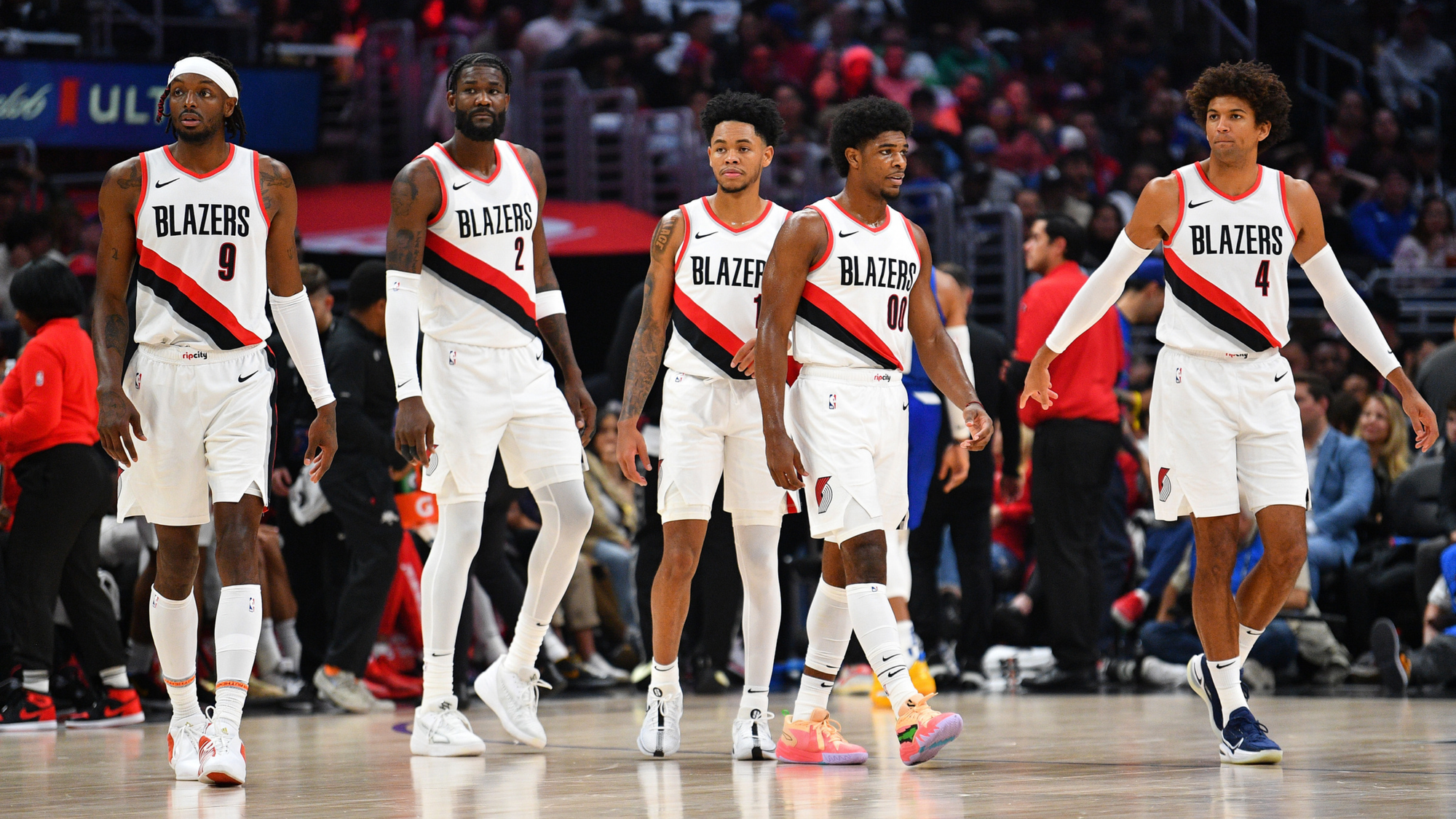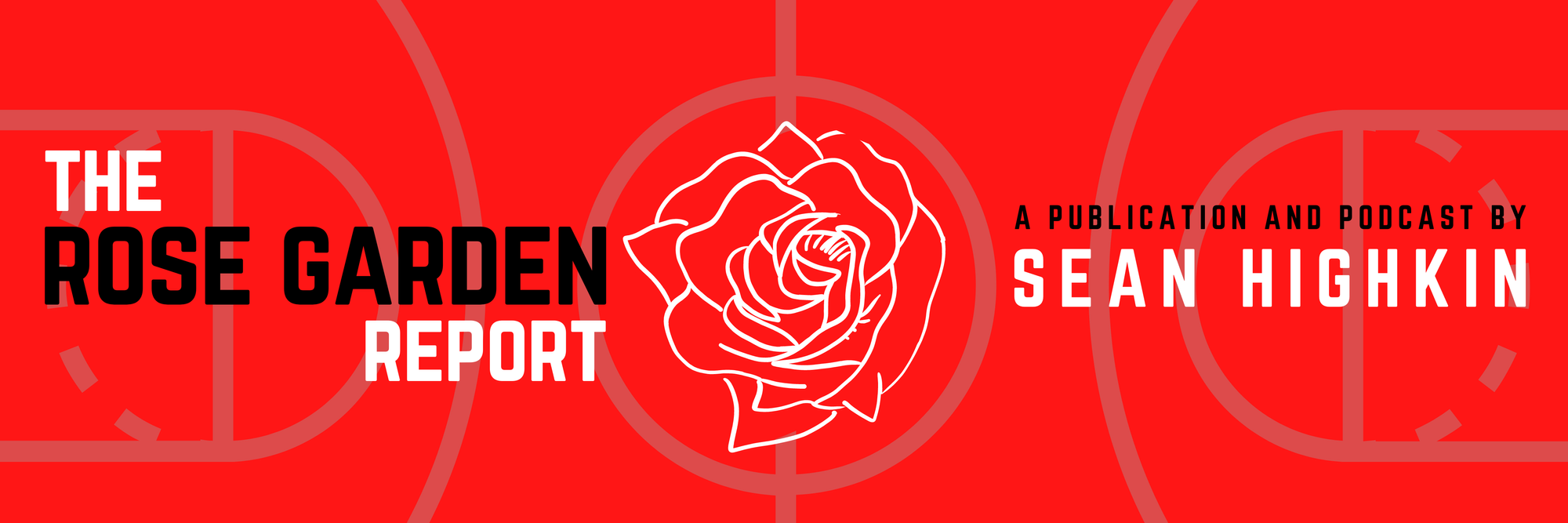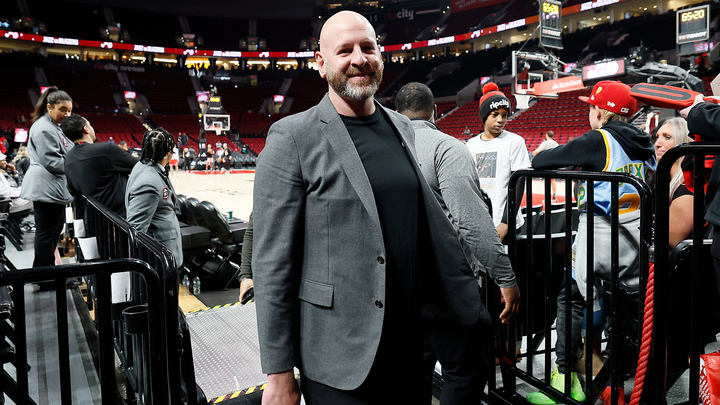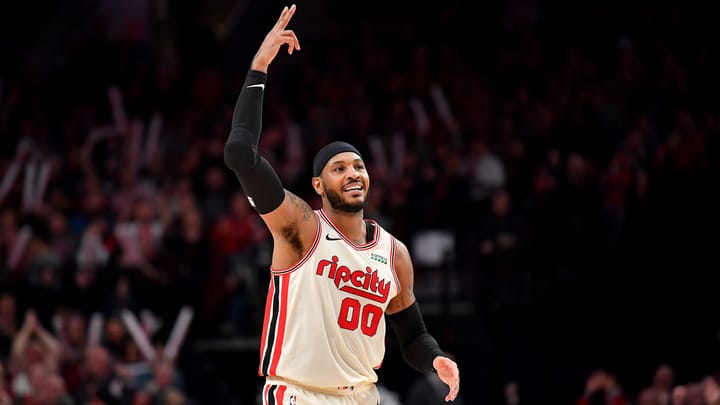A Trail Blazers 2023-24 Trade Season Primer
Today is the unofficial start of the NBA’s trade season. Here’s what the Blazers have to work with and what they might be looking for.

Trade activity around the NBA isn’t going to pick up until closer to the Feb. 8 deadline, but today can still be viewed as the unofficial kickoff. On Dec. 15, most players who signed free-agent contracts during the offseason are eligible to be traded, which opens up a lot of possibilities.
A year ago this time, the assumption was that the Trail Blazers would be buyers at the deadline. The season hadn’t gone fully off the rails yet, so the idea that general manager Joe Cronin would be able to package players and future picks to add another piece to a contender built around Damian Lillard was still a realistic goal.
What ended up happening was quite the opposite. They traded two rotation players, Josh Hart and Gary Payton II, for picks and young players. It was the precursor to both a late-season tank job and an offseason that saw them take Scoot Henderson with the No. 3 overall pick and then Lillard request a trade.
There’s no need to go over all of that again, but suffice it to say that the state of the Blazers in December of 2023 is much, much different than it was in December of 2022. Nobody is under any delusions about this team making the playoffs, and the focus is firmly on individual development and giving Chauncey Billups the space to build the kind of identity he wants the team to have.
So far, the organization is happy with where things are at this early stage of the rebuild. When it comes to what they might do at the deadline, it’s pretty safe to say they won’t be buyers. But will they be sellers? At this point, it’s tough to say. We won’t know until closer to the deadline. But now that a lot more things are on the table, it’s worth taking stock of everything they have to work with and which players might or might not be on the block between now and February.
The Financial Picture and Available Trade Tools
As of today, the Blazers are $3.5 million below the luxury-tax line. It should go without saying that a rebuilding team isn't going to go into the tax like they might be willing to if they were looking to add pieces to make a title run. So just keep that in mind.
In addition to player salaries (we'll get to those in a bit), Portland also has two decent-sized trade exceptions they could use to add a player. One, from last deadline's Gary Payton II trade, is for $8.3 million and expires at this year's deadline; the other, from the Lillard trade, is for $8.8 million and expires in late September.
The Blazers were recently awarded a $5.8 million Disabled Player Exception after Robert Williams III underwent season-ending knee surgery. They have until March 10 to use it, and it can be used to take back a player up to that salary in a trade, but only if that player is on an expiring contract.
It should be noted that Portland currently has all 15 of its roster spots filled. If they trade one of their higher-salaried players (like Jerami Grant or Malcolm Brogdon) for multiple players, they'll have to waive at least one player to make the deal legal. All but three of their contracts are fully guaranteed. Moses Brown's $2 million salary is only $500,000 guaranteed until Jan. 10, the league-wide date that non-guaranteed contracts become fully guaranteed for the rest of the season. Skylar Mays' $1.7 million salary has an $850,000 guarantee until Jan. 10. Ish Wainright’s $1.9 million salary is fully non-guaranteed before that date.
(Of the three, I'd peg Wainright as the most likely to be waived, because he doesn’t have any guaranteed salary and hasn't cracked the rotation in any real way this season as he’s dealt with injuries. But I would anticipate that cutting someone would be done in conjunction with converting Duop Reath from a two-way to a standard NBA contract, which they'll have to do before the end of the season so Reath doesn't hit the 50-game limit for players on two-way contracts.)
Teams in the Blazers' early phase of rebuilding aren't usually in the business of trading away future draft picks—if anything, they'd likely look to add more of them in whatever deals they make. But for posterity, these are the picks they have from other teams that they could trade if they wanted to:
- 2024 first-round pick from Golden State (top-4 protected in 2024, top-1 protected in 2025, unprotected in 2026)
- 2024 second-round pick from Atlanta
- 2024 second-round pick from Charlotte or Minnesota (more favorable)
- 2025 second-round pick from Atlanta (protected 41-59)
- 2026 second-round pick from Memphis (protected 31-42)
- 2028 first-round pick swap with Milwaukee (unprotected)
- 2028 second-round pick from Golden State
- 2029 first-round pick from Boston (unprotected)
- 2029 first-round pick from Milwaukee (unprotected)
- 2030 first-round pick swap with Milwaukee (unprotected)
Their own first-round pick is still tied up by Neil Olshey's 2021 trade with Chicago—the Bulls have their pick if it's outside the lottery at any point up to 2027, which limits their ability to trade their future firsts. Nobody expects that pick to convey to Chicago for at least the next couple of years (they're going to be in the lottery for the foreseeable future), and as I said, rebuilding teams don't trade away draft capital, so this almost definitely isn't going to come into play before the deadline, but it's worth mentioning.
(Last spring, I wrote a much more detailed explanation of the protections on the pick they owe the Bulls and how they could get around them. You can read that here if you're interested. It's not worth getting into again right now because they aren't going to do anything with it before the deadline.)
Which Players Will or Will Not Get Traded?

For all intents and purposes, the Blazers have six players worth discussing here. Since they're young and rebuilding, most of the team is either on rookie contracts or minimum deals, and either aren't on the trade block or won't be worth much.
Scoot Henderson and Shaedon Sharpe are the closest thing to "untouchable" and aren't going anywhere. Jabari Walker and Toumani Camara are young and productive on ultra-cheap second-round pick contracts that there's no reason for a rebuilding team to trade. The other two rookies, Kris Murray and Rayan Rupert, have barely played and have more value to the Blazers long-term than they would on the trade market. Ish Wainright, Skylar Mays and Moses Brown are end-of-bench guys on minimum contracts who don't factor into trade talks in any real way.
That leaves the six veterans on significant contracts. Some are very clearly not going to be on the trade block; others might well be elsewhere by February. Let's break them down.
Deandre Ayton
Contract details: $32.5 million in 2023-24, $34 million in 2024-25, $35.6 million in 2025-26.
Given how things ended in Phoenix, Ayton was something of a distressed asset when the Blazers traded for him as part of the Lillard deal. Both he and Billups are still feeling out what his ideal role and usage level should be in the offense, but overall, the first year of the “DominAyton” experience in Portland has been more good than bad. Plus, he’s on a big contract that isn’t going to have a lot of value right now on the trade market. Don’t expect anything to happen with him before the deadline.
Jerami Grant
Contract details: $27.6 million in 2023-24, $29.8 million in 2024-25, $32 million in 2025-26, $34.2 million in 2026-27, $36.4 million player option in 2027-28. Cannot be traded until Jan. 15.
As we get closer to the deadline, you're going to hear Grant's name come up a lot in columns and podcasts speculating about deadline trade targets for contenders, because the way this stuff is talked about now, no team that isn’t trying to contend would have any reason to employ a single good player over the age of 25. The reality is a little more nuanced than that.
The Blazers love Grant, on and off the court, and see him as someone they want to continue building with. At 29, he’s significantly older than most of their other core pieces. But since the beginning of training camp, Cronin and Billups have stressed the importance of having veterans on a young team. The emphasis on cap flexibility and future assets in a lot of mainstream NBA discourse often makes it seem like a binary choice around this time of year—you’re either rebuilding and your roster is entirely young, or you’re contending and your roster is entirely older. There’s something to be said for just having good basketball players on your team, no matter what stage of the team-building process you’re in.
Grant has been the Blazers’ best player this season. Before he suffered a concussion in Utah on Dec. 2, he was putting up his best numbers since his first season in Detroit in 2020-21—the best of his career in some cases. Assuming he’s out of the NBA’s concussion protocol soon (he’s not quite there yet, but he has started doing some on-court work at practice) and picks up where he left off, the talk is going to pick up around the league, even though the Blazers have given no indication, internally or externally, that they’re interested in moving him.
If Grant asks to be traded, I think Cronin would take care of him. But I don’t see him wanting to go anywhere right now, either. There’s an assumption that every player of a certain age and experience level is singularly focused on getting to a contender ASAP, regardless of their comfort or anything else going on in their lives, but that usually isn’t the case. You have to remember that Grant left a Denver team in 2020 that had just made the Western Conference Finals to sign with Detroit because he wanted a bigger role. By all accounts, the Nuggets offered the same money as the Pistons, and Grant could have thrived in the Aaron Gordon role if he’d stayed, but that’s not what he wanted.
That isn’t a value judgment at all—everybody has different priorities in their life—but it’s what happened. And in Portland, Grant has it pretty good: he got paid, he has a featured role in the offense, and he likes the city and organization. He also became a father over the summer, and I don’t think he’s itching to move his family somewhere else in the middle of the season.
There’s also the matter of positional need that makes it less likely Grant will be moved before the deadline. We’ll get to Brogdon in a bit, but since the Blazers have three young guards they’re building around long-term, you can logically assume they’re not closed off to the idea of moving him. Grant being the starting power forward at his age and salary isn’t blocking the playing time of anyone who would need him to be gone to open that up. Camara has mainly been playing small forward and Walker has gotten time both as backup power forward and smallball center. Neither of them are being held back by Grant’s presence.
That’s not to say Grant absolutely won’t be traded if Cronin gets an offer he can’t turn down, or that they won’t explore the idea at some point before his five-year contract is up. But if you’re putting him on the Lakers for the D’Angelo Russell salary-filler package just because he “makes sense” for a contender to pursue, all you’re doing is filling space on your trade-deadline podcasts. (Not that there’s anything wrong with that! The content game is the content game.)
Anfernee Simons
Contract details: $24.1 million in 2023-24, $25.9 million in 2024-25, $27.7 million in 2025-26.
At the moment, Simons is more valuable to Portland than he would be on the trade market. Since his return from the thumb surgery that's sidelined him since opening night, having a high-volume scorer has taken a lot of pressure and defensive attention off of Henderson and Sharpe. And because of that thumb injury, his value around the league is pretty low right now. For a lot of reasons, the timing doesn't make sense to move him, and I'd be shocked if they did.
Malcolm Brogdon
Contract details: $22.5 million in 2023-24, $22.5 million in 2024-25.
Along with Grant, Brogdon is going to get the most national attention of anyone on the Blazers' roster as a trade candidate at the deadline. Of the two, it's much more likely Brogdon is actually traded than Grant. The list of teams that could have interest before the deadline isn't quite as long as the list of teams that wanted Jrue Holiday. But Brogdon is the kind of player most teams with playoff aspirations would love to add, so there will likely be offers involving first-round picks.
The Blazers' decision of whether or not to move Brogdon will depend on how much growth they see from Henderson in the next two months. Even though Portland isn't going to be a playoff team, they don't want to throw the No. 3 overall pick into a starting role playing 30-plus minutes a game with no safety net. In that way, having Brogdon on the roster has been enormously valuable in allowing Billups to not give Henderson more than he can handle.
Today, 23 games into the season, Henderson is very clearly not ready to be a full-time starting point guard yet. Will that change between now and February? If Henderson continues to struggle the way he has, taking off the training wheels may not be worth it. If he makes major strides, that makes the idea of trading Brogdon much more palatable.
If Brogdon was on an expiring contract, it would be a lock that they'd trade him this season so they don't lose him for nothing (that’s what happened with Josh Hart last deadline). He's about as much of a known commodity as it gets on the court and is making the same money next year as he is this year. In all likelihood, whatever offers come in for him at the deadline will still be there this summer. They could trade now, or not.
Robert Williams III
Contract details: $11.6 million in 2023-24, $12.4 million in 2024-25, $13.3 million in 2025-26.
If he hadn't gotten hurt, Williams might have had the most trade value of any of the Blazers' veterans as a Defensive Player of the Year-caliber center on a below-market contract. But he's out for the season after undergoing knee surgery, which means the sorts of teams that would have been suitors (i.e. contenders) are probably not interested anymore. If Williams' recovery goes well, there might be some trade interest in the summer. But more likely, the earliest that will pick up is after the start of next season. He needs to prove he can stay healthy, which has been the biggest issue throughout his career.
Matisse Thybulle
Contract details: $10.5 million in 2023-24, $11 million in 2024-25, $11.5 million player option in 2025-26. Contract includes a 15 percent trade kicker. Cannot be traded until Jan. 15. Because Portland matched Dallas' offer sheet, Thybulle has the right to veto any trade for the first year and cannot be traded to the Mavericks during that time.
The Blazers are currently tied for the 15th-ranked defense in the league (114.2 points allowed per 100 possessions) after being a bottom-five team at that end each of the last four seasons. Thybulle is a major reason for that jump. He’s also become a viable shooting threat, which he never was in Philadelphia, and it’s past the point where that can be seen as a fluke. Between the start of this season and last year after he came over at the deadline, he’s shot 40.2 percent from three-point range on 3.9 attempts per game as a Blazer, and the 45 games he’s played in that time are over a half-season of sample size. There’s nothing else to do but accept that it’s legit.
Between that kind of two-way production and the very reasonable three-year, $33 million offer sheet he signed with Dallas that the Blazers matched, Thybulle could absolutely be someone contending teams call about. It remains to be seen whether or not Portland is interested in moving him. It could go either way—they’d be happy to keep him because he fits with both their play style and rebuilding timeline and is a popular teammate, but if they get a compelling offer, it’s possible they do it.
Because Thybulle’s contract is an offer sheet the Blazers matched, he has veto rights over any deal for the first year. It’s too early to know what either side is thinking there. It should also be noted that he can’t be traded to the Mavericks at all until July 1, because they’re the team that signed him to the offer sheet.
What are the Blazers Looking to Add?
This isn’t hard to figure out. If they do decide to move any of their veterans, they’ll be looking for draft capital and young players that fit with what they’re trying to build. I’m not sure salary relief will be a focus, because they don’t really have any bad contracts on their books that they’re motivated to unload. Grant’s number is big, but he’s a productive player they like, so it isn’t the kind of “albatross” deal they’re looking to get off in order to clear the books. A lot of that work was done at the 2022 deadline when C.J. McCollum and Norman Powell were shipped out, and their last “bad” contract was Jusuf Nurkic, who went to Phoenix as part of the Lillard-Ayton deal. Their most high-priority young players are all on rookie contracts still.
They may want to be a little more selective with young players they bring in, too. Last year, once they shut down Lillard and their other veterans and embraced the tank, they didn’t have much they knew about any of their players outside of Sharpe. They could throw Cam Reddish out there for extended minutes and see if he stuck. (To Reddish’s credit, he seems to have finally found a nice role for himself with the Lakers this season.) This time around, they have a list of young players in-house that they like and want to keep developing: Henderson, Sharpe, Camara, Walker, Murray and Rupert. Whoever they bring in has to fit around that.
They’re also in good shape for the upcoming draft. They have their own pick, which will inevitably be very high, and the Warriors’ top-four protected pick that could be higher than expected in light of Draymond Green’s indefinite suspension this week. We’ll start getting into draft stuff a few months from now, but the consensus from people in that realm is that the 2024 class isn’t the strongest. There’s no Victor Wembanyama to tank for, like there was last year, or a Cooper Flagg like there will be in 2025. More picks in this draft won’t do them much good—they’d likely prioritize picks in future drafts. But when you’re rebuilding, you can never have too many picks, either to use yourself or trade. Oklahoma City is the model there.
The Blazers’ roster could take any number of directions before the deadline. It may be a quieter deadline than many anticipate—a couple of veterans may be moved out, but it’s unlikely to be a 2022-style full-scale teardown.




Comments ()